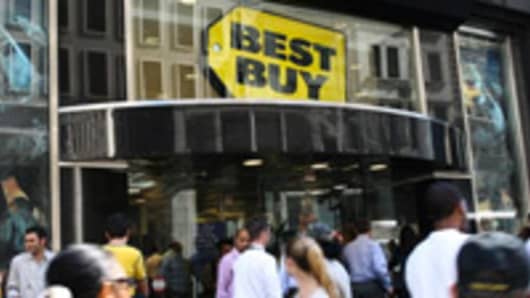Best Buy has its work cut out for it. Even
CEO Brian Dunn admits that.
You’ve got to like Dunn. He’s a Best Buy lifer, that rarest of CEOs who went from the shop or showroom floor to the corner office. He sold TVs in a Minneapolis store. Now he runs the company that sells more flatscreens than any other retailer anywhere, Wal-Mart included.
Gregarious, dedicated, disarmingly down-to-earth, he’s really never worked anywhere else. He clearly relishes being CEO of the company he loves.
But when I asked him which job at Best Buy he enjoyed the most during his 26-year career with the company, he responded without a second’s hesitation: store manager.
And that may be Dunn’s problem.
Dunn, you see, believes deeply in the big box’s big boxes. Maybe too deeply. He loves stores. Physical stores. Brick and mortar stores. Big 35,000- to 45,000-square foot places where you the shopper can see, touch, hold and hear the latest electronic devices or peer through the French doors of the newest $3,000 refrigerator.
Now, to be clear, Dunn, who became CEO in 2009 at possibly the unluckiest moment in America’s recent economic history, also believes in Best Buy online and in the chain’s 279 smaller-format Best Buy Mobile stores. They’re stocked with the hottest smartphones, tablets and superslim ultrabooks. Both of those divisions have been bright spots for BBY. Online sales, for example, have been growing at a 20% clip lately.
Still, online sales are just 5 percent of the company’s $50-billion-plus total. And while Dunn points with justifiable pride to online’s double-digit growth rate, he concedes Best Buy the brand isn’t regarded as an online powerhouse. That distinction goes, of course, to Amazon .
It’s easy to see why. First, when people think of Best Buy, they think of the big blue-and-gold megastore. It’s notoriously hard for a traditional store-based retailer to shed its past (think Sears), just as it’s difficult for a print publisher to reinvent itself for the digital age.
Second, and far more important, Best Buy will not necessarily always be the best buy online. Although the company will always match a rival physical store’s price on an identical item, it does not, as a matter of policy, always promise to beat an online competitor’s best price.
Walk into your local Best Buy, see the computer or TV you want and then shop for a lower price online. Chances are, you’ll find it. Online prices are typically 10% lower than in-store prices. And when you do go online to shop, there’s no guarantee Best Buy’s deal will be, well, the best buy.
There are multiple reasons for those pricing discrepancies. But the one that’s hardest to ignore, finesse or fix is this: Best Buy has almost certainly got too many expensive big boxes. Each of Best Buy’s 1,100 large-format outlets has a manager, a staff of 40 or more (more during the holidays), typically a big fat long-term lease and thousands per year in additional costs for such items as electricity, insurance and displays.
You’ve got to figure that some percentage of those big boxes – 10 percent, 20 percent, 50 percent? – has gone from profit-maker to profit-taker as more and more shoppers turn online to buy consumer electronics. And surely more stores will flip from black to red as consumers make even more use of the instant price discovery features online and on their smartphones.
Now, unlike some critics of the chain, and of Brian Dunn, I don’t believe that all or even most of Best Buy’s big boxes are going to disappear. Maybe not ever, and certainly not soon. After all, Best Buy still commands 20 percent of the U.S. market for consumer electronics. That share has remained fairly steady in recent years and is almost three times Amazon’s portion.
That tells you millions of people like to see, touch and experience electronics products before they buy them. There’s a value for that, a value that only a showroom can provide. And many consumers — like me — place a value, too, on the ability to walk into a store and walk out with a product in hand. Americans like the social aspect of shopping and they treasure instant gratification.
Nevertheless, Dunn and Best Buy have some real tough decisions to make. What is the right size of a consumer electronics store in today’s connected world? Are the big boxes that seemed so dazzling 10 or 15 years ago still relevant today? Will they be 10 years from now? And if they are — or are for some people — how many of the 40,000-square-foot emporiums do you need? More to the point, how many can you afford?
To be fair, Dunn says he plans to reduce the footprint of his big stores by 10 percent or so over the next five years. Some stores may close; others, he says, will be downsized, with space sub-leased to other retailers. (Starbucks , anyone?) Best Buy isn’t adding big boxes these days either, says Dunn.
But for a store guy like Dunn, even those 10 percent nips and tucks have got to be painful. For shareholders, who’ve seen Best Buy’s stock slide 31 percent in a year, the question is, will they be enough?



